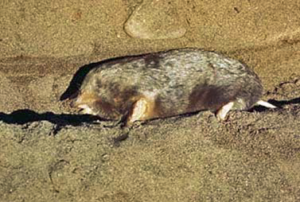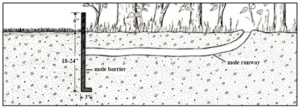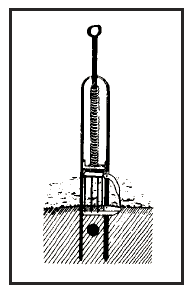 |
|
Eastern mole |
There are two species of moles in Indiana. The Eastern mole (Scalopus aquaticus) is the most numerous and widespread, and is responsible for most of the complaints concerning mole damage to lawns and gardens. The star- nosed mole (Condylura cristata), found in the northern part of the state, is not an important mole pest.
Moles are not rodents. They belong to the group of mammals known as insectivores, and thus are related to the shrew. Eastern moles have pointed snouts, greatly enlarged, rounded front feet with stout claws, and a short, nearly naked tail. They are six to eight inches long with short, velvety fur that is usually gray to silvery-gray. The eyes and ears of moles are very small and are concealed in the fur.
Moles can be destructive pests in lawns, gardens, nurseries, parks, golf courses, and cemeteries. During their burrowing activities, they produce mounds and ridges that disfigure lawns and sometimes dislodge plants or injure plant roots. Their mounds also provide a medium for the germination of weed seeds.
Despite the damage done by moles around yards and gardens, there are aspects of this unique mammal which are beneficial. Moles make soils healthier because their tunnels permit air and water to penetrate deeper soil levels. Moles feed voraciously on all types of insects found in the soil, some of which are serious pests of lawns, gardens, and horticultural plants.
They are also part of the food chain in the wildlife community, providing food for some hawks, owls, and snakes. And finally, the mole’s unusual subterranean life provides one of the most fascinating studies found among wildlife.
Biology and Behavior
|
Adult weight:
|
3-4 ounces.
|
|
Total length:
|
6-8 inches. |
|
Color:
|
Gray to silvery-gray. |
|
Gestation:
|
42 days. |
|
Litter size:
|
3-5.
|
|
Life span:
|
3 years.
|
Moles feed primarily on earthworms, beetle grubs, ants, and other animals which live in the soil. A smaller part of their diet consists of various seed and vegetable matter. They usually do not eat bulbs or the roots of garden plants. Several species of mice also use mole runways; often these are the culprits responsible for the occasional damage to roots and tubers in flower and vegetable gardens.
Moles are active day and night throughout the year, but they are most active near the earth’s surface during the spring and fall on damp days or following rain showers. When the ground surface becomes frozen in the winter, or very dry during the summer, moles use only the deeper burrows. Daily peak activity periods are during the morning hours, although moles may be seen working off and on throughout the day and night.
Mating occurs during February and March, with a single litter of three to five young born later in the spring following a six-week gestation period. Young moles grow rapidly and leave the nest to fend for themselves at about one month of age.
Biology and Reproduction
|
Adult weight:
|
4 ounces.
|
|
Total length:
|
7 inches.
|
|
Color:
|
Grayish-brown.
|
|
Gestation:
|
42 days.
|
|
Litter size:
|
Three to five.
|
|
Litter number:
|
One litter per year, born March to early April.
|
|
Weaning:
|
1 month.
|
Nests and Runways
The nests, usually four to 16 inches below ground, are located either in protected areas underneath objects, such as boulders, trees, stumps, and fence rows, or randomly within the tunnel system in open field areas. Nests are slight enlargements of the tunnels and are lined with bits of leaves or grass.
Two types of runways (tunnels) are produced by moles: surface runways and deep runways. Certain tunnels of both types are used as major lanes of travel (called main runways) and may be used by several moles in the area.
Surface runways are commonly seen as the raised ridges running through lawn areas. The mole is capable of extending surface runways at the rate of 100 feet per day. Surface runs may be used daily, may be revisited at irregular intervals, or may be used only once and then abandoned. They connect with the deep runways, which are located between 3 and 12 inches below the surface. Generally, few or no mounds are produced as a result of the production of surface tunnels.
Deep runways are usually main runways, since they are used daily as the mole travels to and from surface runways or the nest. The soil excavated from the deep tunnels is deposited on the surface through short vertical tunnels in volcano-like mounds. (Mole mounds should not be confused with pocket gopher mounds which are horseshoe shaped.)
When fence rows, concrete paths, or other man-made borders are within mole-active areas, the moles tend to construct their main runways along the edges of these artificial borders. It is also common for the main runways to follow a woody perimeter of a field or yard. Surface runways that are not used as main runways commonly branch off from these border runs towards the center of a field or yard (Figure 1).
The number of mounds or surface ridges seen in a yard is no indication of how many moles may be present. Generally, one acre of land will support no more than two or three moles at one time. However, yards surrounded by or adjacent to large tracts of forested areas or weedy fields may be subject to continual invasions by moles, because such areas may support many moles.
Control by Trapping
Trapping is the most reliable method of mole control. The key to success is patience, practice, and persistence. Moles have an uncanny ability to detect and spring improperly set traps. So place traps carefully, and keep trying until experience leads to success.
When and Where to Trap. Generally, trapping is easiest and most effective during the spring and fall, when mole activity is at a peak. Once mole activity is noticed, control efforts should begin as quickly as possible to keep damage to a minimum. Also, trapping in the early spring can eliminate pregnant females, thereby reducing the likelihood of having to contend with a family of moles.
For successful trapping, it is essential to locate the main runways. To identify main runways in a yard or area, look for runways which:
- follow more or less a straight course for some distance;
- appear to connect two mounds or two runway systems;
- follow fence rows, concrete paths or other man-made borders, or;
- follow a woody perimeter of a field or yard.
 |
|
Fig. 1. A network of mole runways in a yard. The arrows indicate good locations to set traps. Avoid the twisting surface ridges, and do not place traps on top of mounds. |
Active surface main runways can also be determined by poking small holes with your finger into the runways at several locations throughout the system. Moles will repair these holes in their main runways within a day or two. Identify these holes using a stick or other type of marker so you can inspect them at a later date. Runways not repaired over a longer period of time are not worth trapping.
Also, because nests are commonly located at protected spots along the edge of areas, such as hedgerows or fence rows, border trapping at the places where runways enter the yard, field, or garden often provides good results (Figure 1).
Unless the mole activity is extremely light, more than one trap should be used. Use between three and five traps per acre for quick results. If possible, one trap should be placed in each of the above mentioned main runway areas.
How to Trap. There are several different types of mole traps, but the harpoon trap is probably the easiest trap for the novice to use, and is readily available from most hardware and garden shops.
To properly set a harpoon trap on a surface run, carefully follow these steps:
- Measure the depth of the tunnel using your finger or a stick. The bottom of the mole run should be no deeper than the length of the trap spikes. Remove a larger layer of soil if the run is deeper than the spikes.
- Using the side of your hand, lightly press down a narrow section (approximately one inch in length) of an active runway so that the runway is collapsed to half of its original diameter.
- Push the supporting spikes of the trap into the ground, one on either side of the runway, until the trigger pan just barely touches the depressed tunnel. Be sure the trap is centered over the runway and supporting spikes do not cut into the tunnel below (Figure 2).
- Pump the spring of the trap up and down a couple of times so the spikes can clear any obstructions.
- Set the trap and leave it, taking care not to tread on or disturb any other portion of the runway system.
- Place a bucket up-side down over the trap to protect kids and pets.
- Check the trap once or twice a day. If a trap fails to produce a mole within 4 or 5 days, move the trap to another portion of the main runway system.
- In order to prevent moles from going around your trap, make an underground fence of small garden stakes or popsicle sticks spaced approximately one inch apart and extending ten inches on either side of the trap.
- After you have trapped out your moles, collapse and fill in all visible tunnels and burrows. A vacant tunnel system is an invitation to stay for the next mole passing through your yard.
Do not use motor oil or WD-40 to lubricate traps. Remove rust and dirt with a wire brush, and lightly lubricate with mineral oil only.
Other Approaches to Control
Grub Control. It is often suggested that if you eliminate grubs from lawns you will eliminate the moles. But grubs make up only a portion of the mole’s diet, which also includes earthworms and other soil animals. Thus, moles often are present in grub-free lawns. The loss of earthworms and other beneficial insects through repeated applications of insecticides will generate a heavy pesticide load and may cause more problems than the moles. Addi-tionally, the moles may not move far from the treated lawn, and they may periodically re-invade the lawn in search for food or the opposite sex. And because the moles are not directly eliminated, they may live in nearby areas for as long as 3 to 5 years. In short, chemical treatments can be an expensive approach to mole control, with little likelihood of long term success.
Poison Gases and Baits. Attempting to kill moles with poisonous gases (fumigants) is largely ineffective. Fumigants require an air-tight system to produce the desired result. Since the gases produced are not capable of sufficiently penetrating throughout the mole’s extensive runway system, and/or will escape through the top of the surface runways, this method provides little or no control.
Like poison gases, most poison baits (nuts and grain pellets) provide inconsistent results. In many cases, these baits are ineffective because moles feed primarily on earthworms and other sub-soil insects. Some of the newest registered mole baits attempt to mimic worms in a gel-type formula or in an artificial worm design. These may prove to be more readily accepted by moles. When using poison baits, the best results are usually obtained during the cold weather months when insect activity is at it’s lowest. Baits should be applied within the underground runways only since baits exposed on the surface are not readily consumed by the moles and also pose a hazard to other animals, such as dogs, cats, wild birds, and squirrels, which may consume them.
Repellents. Currently, there are several mole repellents on the market. These repellents are based on castor oil. Some success has been reported with these products, but no scientific research has shown a consistent result.
Direct Removal. If the use of mole traps is not a desirable or practical approach, moles can be killed or captured and removed by conducting a “mole watch” in the spring and fall on days when moles are active. Caretakers of golf courses sometimes conduct mole watches or hire high school students or retirees to conduct a mole watch for them. Some gardeners make a practice of poking small holes in runways each morning with the hope of later catching the moles in the act of repairing them. Or, portions of the runways can be compressed and marked with a thin wire marker flag placed on top of the compressed tunnel. The movement of the flag alerts the mole watcher to the activity of the mole.
To capture or kill a mole when it is observed tunneling, quietly sneak up behind the mole and insert the blade of a shovel or spade behind it so it cannot retreat back into the completed tunnel. A pitchfork or a hard stomp directly on top of the mole can be used to kill it. Or the mole can be captured alive by scooping it out of the ground with the shovel, placing it in a bucket, and then releasing it in a wooded or weedy field area away from any residences. The mole can then carry on its beneficial and unique role in nature’s scheme of checks and balances.
Another live capture alternative is the Pitfall trap. This is simply a three pound coffee can (or similar container) buried in an active tunnel at a depth that puts the top edge of the coffee can level with the bottom of the mole run. Then cover over the exposed can and tunnel with a board. The mole will be unable to climb out of the can and you can then release the mole in an appropriate area.
Predators. Some domestic dogs and cats demonstrate considerable interest in the various small furry animals which inhabit our yards, gardens, and buildings by occasionally bringing these animals home. Some cats are especially adept at stalking and capturing moles. Dogs and cats are probably attracted to the movement of the earth during tunneling, the high pitched squeaks produced by the mole, and/or the unique musky odor produced by the mole. (Because of this odor, moles are distasteful to most mammals. Thus, they are often captured and killed, but seldom eaten). Dogs and cats which show interest in yard wildlife may provide some mole control if attached to a long leash in the area of the mole activity on mole-active days.
Mole Barriers. When garden plots, seed beds, nurseries, or well-manicured turf areas are surrounded by large tracts of woods or weedy fields containing large mole populations, the installation of a “mole barrier” should be considered. Mole barriers can be constructed from 3.0 ft. widths of galvanized hardware cloth or aluminum sheathing. For best results, the barrier should be buried to a depth of 24 inches. However, if the soil is compacted and hard, a depth of 16 to 18 inches should suffice. Six inches of the barrier should be left exposed above the ground, and three inches of the barrier can be bent out at the bottom to discourage moles from digging under (Figure 3). These barriers can be installed around entire areas or portions of areas (e.g., side of property facing the mole source). Mole barriers offer long term protection, but on areas other than small plots, they may be impractical, unless the problem is persistent and the damage justifies the time and expense of installation.
 |
|
Fig. 3. Mole Barrier. |
Ultrasonic and Other Electronic Devices. There are many ultrasonic and other vibration-producing devices in the market place and sold through various magazines that claim to repel moles, voles, gophers, and other mammals from yard and garden areas. All such devices have absolutely no value in controlling pests (including insect pests). So, buyer beware.
Home Remedies. Many “home remedy” approaches have been tried over the years to combat the mole. Desperate homeowners and gardeners have tried placing various materials irritating to moles in the runways, such as broken glass, razor blades, rose branches, bleach, moth balls, lye, and even human hair. Some gardeners believe chewing gum kills moles via intestinal blockage. Some have hooked up their car’s exhaust system to mole tunnels; others have wastefully pumped hundreds of gallons of water into the tunnels. Frightening devices such as mole wheels (spinning daises), vibrating windmills, and whistling bottles have also been tried. In general, these home remedies have no value in mole control. Moreover, some can be hazardous to human health, companion animals, and wildlife, or detrimental to the environment.
Acknowledgments
The information given herein is for educational purposes only. Reference to commercial products or trade names is made with the understanding that no discrimination is intended and no endorsement by State or Federal Agencies is implied. This program serves people of all ages regardless of socioeconomic level, race, color, sex, religion, disability, or national origin. The Wildlife Conflicts Information Hotline is a cooperative program of the United States Department of Agriculture – Animal and Plant Health Inspection Service – Wildlife Services, Indiana Department of Natural Resources-Division of Fish & Wildlife, and Purdue Cooperative Extension Service.
